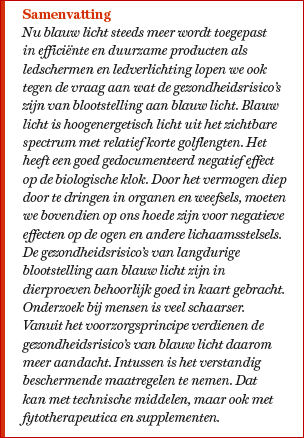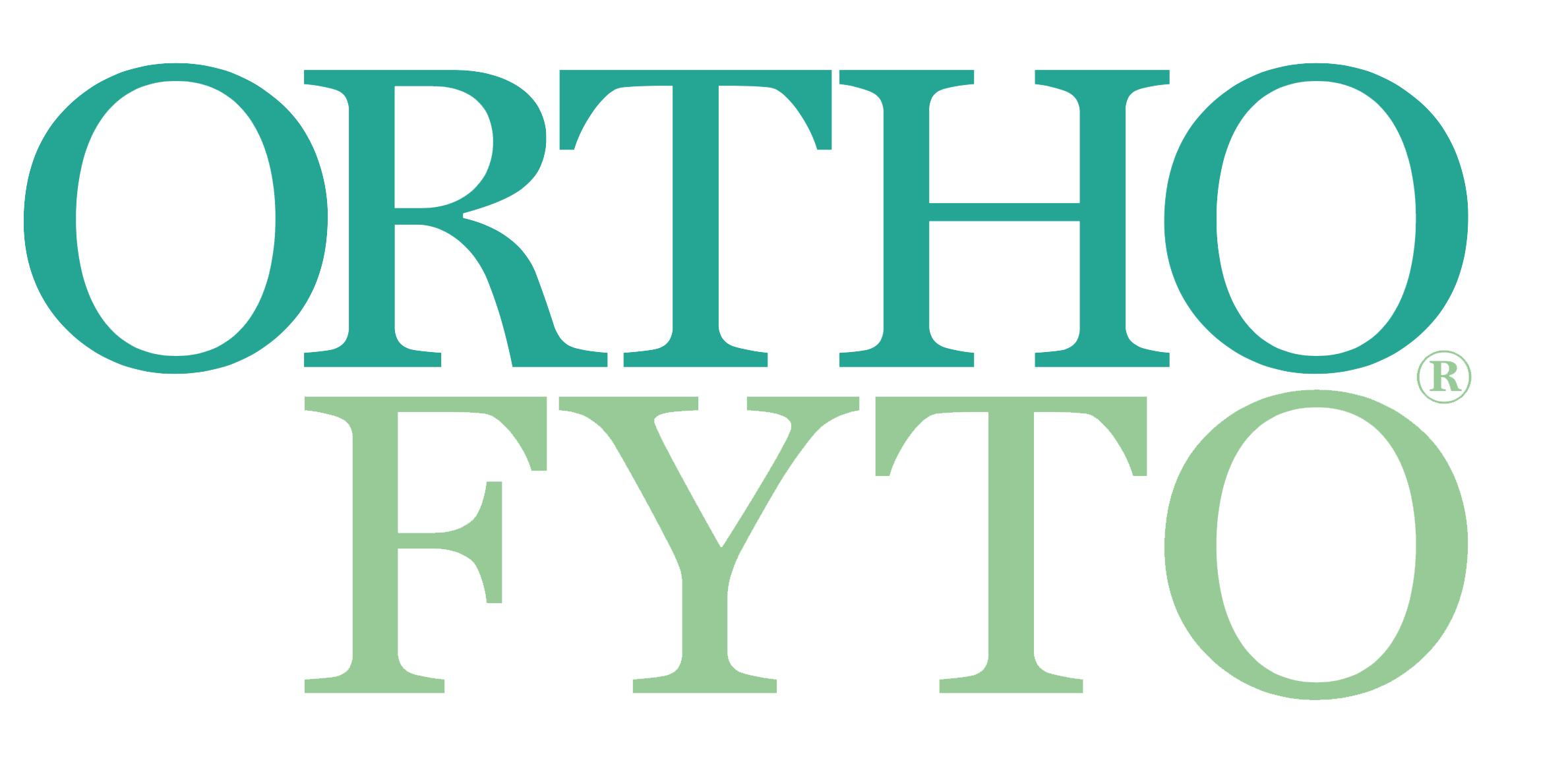De risico’s van baden in blauw licht
02 Dec, 2019
Door Fred Blaauw

Hoe korter de golflengte van een bepaalde kleur licht, des te groter is het doordringend vermogen en hoe sneller er schade kan ontstaan. Dat is bekend van voorbeeld blauw licht (424-500 nm), dat in tegenstelling tot rood licht (620-800 nm) diep in menselijke en dierlijke ogen doordringt. Behalve op de ogen, heeft blauw licht ook andere invloeden op het lichaam. Zoals op de biologische klok. Intussen is in de openbare verlichting en in apparatuur het aandeel blauw licht flink toegenomen.
Wat is eigenlijk blauw licht? Daglicht is kleurloos en samengesteld uit alle segmenten van het zichtbare lichtspectrum met een gelijke intensiteit. Elke soort zichtbaar licht heeft een eigen golflengte, uitgedrukt in nanometers (nm). Langere golflengten bezitten minder energie dan kortere golflengten. De negatieve effecten van ultraviolet licht, binnen het lichtspectrum direct naast het blauw gesitueerd, zijn goed gedocumenteerd. Het kan DNA in cellen beschadigen en kanker veroorzaken. Om zonnebrand te voorkomen, gebruiken we zonnebrandcrèmes en zonnebrillen met uv-filters.
Het eveneens energetisch sterk geladen blauwe licht, heeft een bewezen effect op de biologische klok en kan bij een overmaat te intensief inwerken op de ogen en de huid. Het blauw-violet segment, tussen ongeveer 380 en 500 nm, noemt men ook wel hoogenergetisch zichtbaar licht (High-energy visible, HEV). Met name blootstelling aan licht met golflengtes tussen 380 en 440 nm kan bij intense en langdurige blootstelling gezondheidsschade leveren.
Licht in deze frequentie-range is te vinden in ledschermen en dito lampen in schijnwerpers en straatverlichting, xenon autolampen – bekend als HID-lampen – smartphones met (am)oledtechnologie, oudere pc-monitoren, laptops en tablets en in mindere mate, afhankelijk van de beeldinstellingen, de tv. Op de weg komen we het meest in aanraking met de xenon autolampen, vooral de goedkopere die door een teveel aan strooilicht enorm verblinden, en de moderne straat- en sportveldverlichting. Ledlampen voor huisverlichting kunnen op den duur ook overbelasten. Door nieuwe ontwikkelingen in de productie van ledlampen zijn ze tegenwoordig wel minder risicovol voor onze ogen dan de eerste ledlampen.
- www.gezondheidsraad.nl
- Arora, T., Broglia, E., Thomas, G. N., & Taheri, S. (2014). Associations between specific technologies and adolescent sleep quantity, sleep quality, and parasomnias. Sleep Medicine, 15(2), 240-247.
- Gamble, A. L., D’Rozario, A. L., Bartlett, D. J., Williams, S., Bin, Y. S., Grunstein, R. R., & Marshall, N. S. (2014). Adolescent sleep patterns and night-time technology use: Results of the australian broadcasting corporation’s big sleep survey. PloS One,9(11), e111700.
- Hysing, M., Pallesen, S., Stormark, K. M., Jakobsen, R., Lundervold, A. J., & Sivertsen, B. (2015). Sleep and use of electronic devices in adolescence: Results from a large population-based study. BMJ Open, 5(1), e006748-2014-006748.
- Fobian, A. D., Avis, K., & Schwebel, D. C. (2016). Impact of media use on adolescent sleep efficiency. Journal of Developmental and Behavioral Pediatrics : JDBP, 37(1), 9-14.
- Van den Bulck, J. (2004). Television viewing, computer game playing, and internet use and self-reported time to bed and time out of bed in secondary-school children. Sleep, 27(1), 101-104.
- Cain, N., & Gradisar, M. (2010). Electronic media use and sleep in school-aged children and adolescents: A review. Sleep Medicine, 11(8), 735-742.
- Hale, L., & Guan, S. (2015). Screen time and sleep among school-aged children and adolescents: A systematic literature review. Sleep Medicine Reviews, 21, 50-58.
- Colten HR, Altevogt BM, editors. Sleep Disorders and Sleep Deprivation: An Unmet Public Health Problem. Institute of Medicine (US) Committee on Sleep Medicine and Research; Washington (DC): National Academies Press (US); 2006.
- Ariadna Garcia-Saenz et al. Evaluating the Association between Artificial Light-at-Night Exposure and Breast and Prostate Cancer Risk in Spain (MCC-Spain Study) Environ Health Perspect. 2018 Apr 23;126(4):047011
- J Toxicol Sci. 2018;43(11):659-669. doi: 10.2131/jts.43.659. Melatonin antagonizes oxidative stress-induced mitochondrial dysfunction in retinal pigmented epithelium cells via melatonin receptor 1 (MT1). Yan G1, Yu L2, Jiang S3, Zhu J4.
- Magnavita N. Photoretinitis: an underestimated occupational injury? Occup Med (Lond). 2002 Jun;52(4):223-5.
- Lin CH, Wu MR, Li CH, Cheng HW, Huang SH, Tsai CH, Lin FL, Ho JD, Kang JJ, Hsiao G, Cheng YW. Editor's Highlight: Periodic Exposure to Smartphone-Mimic Low-Luminance Blue Light Induces Retina Damage Through Bcl-2/BAX-Dependent Apoptosis. Toxicol Sci. 2017 May 1;157(1):196-210.
- Pei Chen,† Zhipeng Lai, Yihui Wu, Lijun Xu, Xiaoxiao Cai, Jin Qiu, Panyang Yang, Meng Yang, Pan Zhou, Jiejie Zhuang, Jian Ge, Keming Yu, and Jing Zhuang. Retinal Neuron Is More Sensitive to Blue Light-Induced Damage than Glia Cell Due to DNA Double-Strand Breaks. Cells. 2019 Jan 18;8(1). pii: E68
- Jaadane I. Effects of white light-emitting diode (LED) exposure on retinal pigment epithelium in vivo. J Cell Mol Med. 2017 Dec;21(12):3453-3466
- Marek V, Mélik-Parsadaniantz S, Villette T, Montoya F, Baudouin C, Brignole-Baudouin F, Denoyer A. Blue light phototoxicity toward human corneal and conjunctival epithelial cells in basal and hyperosmolar conditions. Free Radic Biol Med. 2018 Oct;126:27-40.
- Renard G, Leid J. The dangers of blue light: True story! J Fr Ophtalmol. 2016 May;39(5):483-8.. Epub 2016 Mar 31 [Article in French]
- Villalpando Rodriguez GE, Boulenguez P, Chahory S, Carré S, Savoldelli M, Jonet L, Behar-Cohen F, Martinsons C, Torriglia A. Anti-apoptotic effects of Curcuma longa L. extract and its curcuminoids against blue light-induced cytotoxicity in A2E-laden human retinal pigment epithelial cells. J Pharm Pharmacol. 2017 Mar;69(3):334-340.
- Ooe E, Kuse Y, Yako T, Sogon T, Nakamura S, Hara H, Shimazawa M. eCollection 2018. Bilberry extract and anthocyanins suppress unfolded protein response induced by exposure to blue LED light of cells in photoreceptor cell line. Mol Vis. 2018 Sep 24;24:621-632
- Liu W, Lu X, He G, Gao X, Li M, Wu J, Li Z, Wu J, Wang J, Luo C. Cytosolic protection against ultraviolet induced DNA damage by blueberry anthocyanins and anthocyanidins in hepatocarcinoma HepG2 cells. Biotechnol Lett. 2013 Apr;35(4):491-8. doi: 10.1007/s10529-012-1105-2. Epub 2012 Nov 29.
- Lee BL, Kang JH, Kim HM, Jeong SH, Jang DS, Jang YP, Choung SY. Polyphenol-enriched Vaccinium uliginosum L. fractions reduce retinal damage induced by blue light in A2E-laden ARPE19 cell cultures and mice. Nutr Res. 2016 Dec;36(12):1402-1414.
- Ogawa K, Kuse Y, Tsuruma K, Kobayashi S, Shimazawa M, Hara H. Protective effects of bilberry and lingonberry extracts against blue light-emitting diode light-induced retinal photoreceptor cell damage in vitro. BMC Complement Altern Med. 2014 Apr 2;14:120.
- Xu X, Lin X. Molecular mechanism of the protective effect of lutein against retinal damage induced by blue-light in rats. Wei Sheng Yan Jiu 2010 Nov;39(6):689-92. Chinese.
- Madhavan J, Chandrasekharan S, Priya MK, Godavarthi A. Modulatory Effect of Carotenoid Supplement Constituting Lutein and Zeaxanthin (10:1) on Anti-oxidant Enzymes and Macular Pigments Level in Rats. Pharmacogn Mag. 2018 Apr-Jun;14(54):268-274.
- Lima VC, Rosen RB, Farah M. Macular pigment in retinal health and disease. Int J Retina Vitreous. 2016 Aug 15;2:19.
- Hu X, Wu X, Zhao B, Wang Y. eCollection 2019. Scutellarin protects human retinal pigment epithelial cells against hydrogen peroxide (H2O2)-induced oxidative damage. Cell Biosci. 2019 Jan 21;9:12
- Jafri AJA, Agarwal R, Iezhitsa I, Agarwal P, Ismail NM Taurine protects against NMDA-induced retinal damage by reducing retinal oxidative stress. Amino Acids. 2019 Jan 17.
